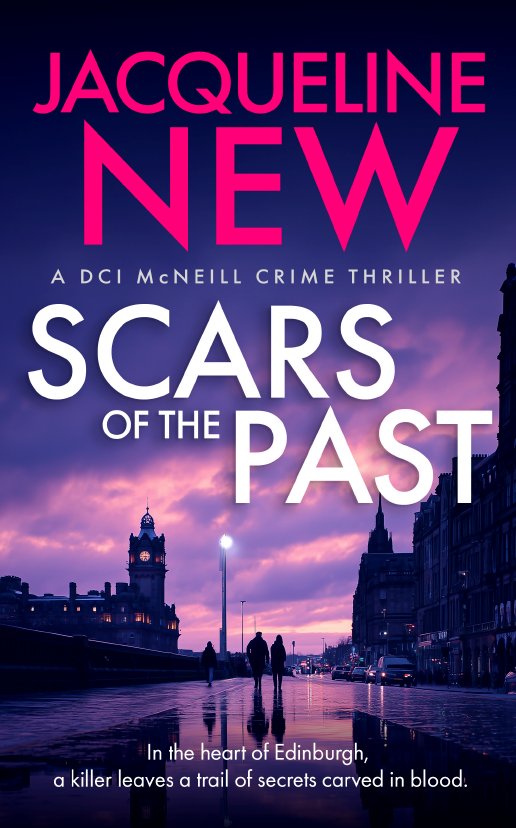HELLO BOOK CLUBS
Thank you for selecting Scars of the Past as your book club pick. I’ve created a resource guide to help make your discussion interesting with insights from me and reader questions.

SCARS OF THE PAST BOOK CLUB KIT
READER RESOURCES
Edinburgh isn’t just a backdrop in Scars of the Past—it’s an integral part of the atmosphere and storytelling. The city’s ancient streets, history-soaked buildings, and noir-esque weather set the perfect tone for this crime thriller.
Edinburgh Noir Photography – Browse Google Images: Edinburgh Noir Photography for cinematic, atmospheric shots of the city at night.
Unsplash Edinburgh Collection – Unsplash: Edinburgh features high-quality, free-to-use photography that captures the city’s mood.
National Library of Scotland Digital Archives – Explore historical maps and archivesto see how Edinburgh’s past influences the present.
VisitScotland: Edinburgh Overview – VisitScotland showcases the history, key landmarks, and eerie hidden spots of the city.
The novel’s forensic and procedural details are grounded in real investigative techniques. If you want to explore the science behind crime-solving, these resources are a great place to start.
Forensic Science in Crime Fiction –Forensic Science: A Very Short Introduction offers an accessible yet in-depth breakdown of forensic methods. Forensic Architecture explores real-world investigative techniques used in crime scene reconstruction.
The Scottish Crime Fiction Community – Bloody Scotland Crime Festival highlights other crime fiction set in Scotland.
Police Scotland offers insights into the history and current structure of policing in Scotland, along with news and case studies.
Throughout the novel, ancient symbols play a key role in both the crime and the deeper meaning behind the investigation. These resources will help you, the reader, understand the historical and mythological significance of these elements.
Wikipedia: Picts– A well-rounded historical overview of the Picts and their culture.
Aberdeenshire Council: Pictish Symbol Stones– Explores the meaning behind the Picts’ mysterious stone carvings.
Stockholm University: DNA Research on the Picts– New discoveries about the genetic origins of the Picts.
Liverpool John Moores University Study – Another recent research project tracing their ancient history.
The Scotsman: 13 Facts About the Picts– A fascinating article about their way of life and mysterious disappearance.
Symbolikon: Celtic Symbols Collection – A beautifully illustrated guide to Celtic iconography that offers a collection of images and files related to Celtic symbols
The Irish Road Trip: 13 Celtic Symbols and Their Meanings – An overview of key Celtic symbols, from the Triskelion to the Triquetra.
"Celtic Symbols" by Joules Taylor – A detailed yet accessible guide to ancient Celtic signs and motifs.
"Celtic Art: From Its Beginnings to the Book of Kells" by Ruth & Vincent Megaw – A more scholarly take on Pictish and Celtic artistic traditions.
Since I’m deaf, I wanted to create a Visual Playlist instead of an audio one—offering a sensory experience through art, images, and text that evoke the novel’s atmosphere.
Flickr Commons: Edinburgh Noir – Explore images of Scotland’s capital.
Google Images: Pictish Symbol Stones – Ancient carvings that inspired parts of the novel.
Forensic Scene Photography – A deeper look at real forensic reconstruction.
Even though I’m deaf, thrash metal has been a crucial influence in shaping McNeill’s character and the novel’s gritty energy. To capture that vibe visually:
Metal Archives – Browse through album art and band photos from thrash metal groups that mirror the raw intensity found in the book.
Genius: Thrash Metal Lyrics – Explore text-based excerpts of thrash metal lyrics that evoke the emotional intensity and aggression reflected in the narrative.
Unsplash: Thrash Metal – A collection of free-to-use images that capture the visual aesthetics of the thrash metal scene.
This Reader Resources Guide is designed to follow the themes and timeline of Scars of the Past, offering an immersive experience that spans Edinburgh’s evocative streets, the forensic intricacies of DCI McNeill’s investigations, and the ancient mysteries of the Picts and Celtic symbols. I hope these resources enrich your reading experience and deepen your engagement with the novel.
Feel free to explore, discuss, and let these resources inspire new insights as you read Scars of the Past.
Thank you again for reading and if you'd like to recommend the books to a fellow crime reader or leave a review that would be wonderful.
Jacqueline
DEAR BOOK CLUB READER,
I'm honoured you've chosen to spend a few hours with Mac and his team in Edinburgh. Thank you for joining me on this journey into Scars of the Past. I want to share a bit about how this book came to be—and a little about me along the way.
There wasn’t some grand masterplan behind the creation of DCI McNeill. One morning during lockdown, I woke up with him almost fully formed in my mind. I found myself scribbling plot points on the backs of shopping lists and petrol receipts, and before I knew it, McNeill was there—a detective who isn’t quite like the ones you see on TV. He’s someone who struggles with social cues, sees the world in unique ways, and uses thrash metal not just as a soundtrack but as a way to calm his mind and cope with the chaos of his job.
I set the story in Scotland because it’s a place steeped in history and folklore—a land I’ve known since childhood through family stories and visits. Edinburgh’s rainy, ancient streets form the perfect backdrop for a tale where every crime, every clue, and every scar from the past carries a deeper meaning.
Scars of the Past isn’t just a police procedural—it’s an exploration of how our personal histories and hidden wounds shape the way we live, love, and seek justice. As you read, I hope you’ll see how McNeill’s relentless pursuit of truth mirrors our own sometimes messy quest to understand who we are.
Thank you for taking the time to delve into my story. I look forward to hearing your thoughts and insights as you explore the complexities of the past and the secrets it leaves behind. Enjoy the discussion!
READER QUESTIONS
How does the title "Scars of the Past" reflect both the physical evidence found at crime scenes and the internal emotional wounds carried by characters like DCI McNeill?
The novel is rich with graphic descriptions and unsettling details. In what ways do these vivid scenes—especially the forensic and powerful imagery—enhance the overall atmosphere of the book?
Celtic symbols and inscriptions appear repeatedly throughout the story. What do you think these symbols represent? How might they tie together the themes of fate, history, and personal guilt?
McNeill’s personal life is deeply intertwined with his professional duties. How do his past relationships and internal conflicts influence his approach to the investigation and his view of justice?
The narrative frequently juxtaposes the gritty urban setting of Edinburgh with moments of reflective introspection. How does the setting contribute to the tone of the story and the characters’ sense of isolation or entrapment?
How does the author balance the police procedural elements with the psychological and emotional dimensions of the characters? Do you find one aspect more compelling than the other?
In what ways do secondary characters—such as Melissa, Clio, and even figures like Karen Martins—help to illuminate McNeill’s character and the broader themes of redemption and responsibility?
The investigation is not just about solving a crime—it's also a journey into the characters’ personal demons. What parallels do you see between the external murders and the internal scars the characters bear?
The manuscript hints at a darker undercurrent involving corruption and the influence of past misdeeds. How does this tension between duty and personal vendetta drive the narrative forward?
Finally, after reading the manuscript, what do you think the author is saying about the inevitability of confronting one’s past? Is there a sense that the characters must ultimately face what they’ve tried to bury?

